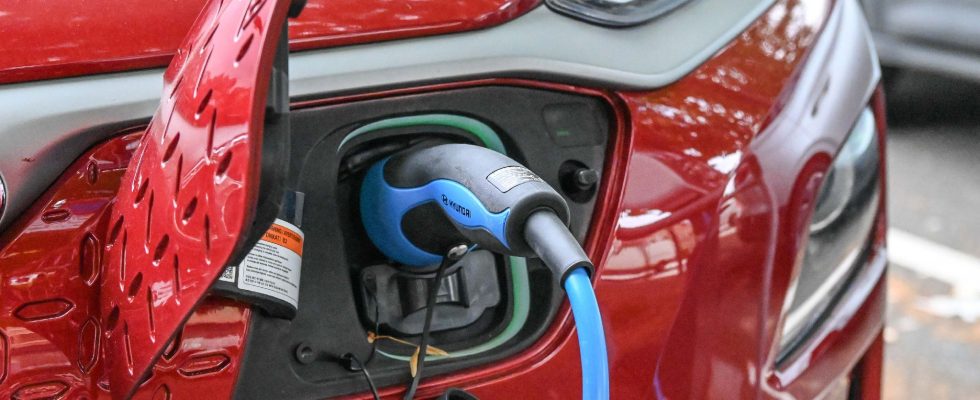It took him some time, but public opinion ended up changing. Driven by global warming, when its effects suddenly shifted from research labs to the streets and the countryside. The recurrent air pollution in the big cities, the repeated heat waves, the forest fires of summer 2022 in Gironde or the water shortages of last winter convinced her that it had become urgent to do something. But what ?
Like its customers, the automotive industry has long remained deaf to the sirens of environmental combat. French manufacturers, in particular, had erected diesel and its fine particles as an emblem of their know-how and their success. Today everything has changed. Motivated by a growing share of motorists, but also by rental companies, company fleets and incentives from public authorities, brands compete in green virtue. They innovate, communicate, multiply the models and the effects of announcement… Except for this “detail”: at the same time, they always sell more heavy and polluting SUVs.
This paradox – this double talk, denounce the gossip – is illustrated by these figures: 30,000 zero-emission vehicles were sold in February alone, which brings their number in French garages to some 700,000, against 512 000 two years ago. 700,000, or almost… the number of SUVs sold in France last year, admittedly lower by around 150,000 units than in 2018, but higher than that recorded in 2020. Clearly: the dynamic is stronger on the side of the clean car, but the curves are still far from crossing.
An electric debate
But by the way, what exactly is a clean car? The answer is not self-evident. We know what a “dirty” car is: the World Health Organization (WHO) has classified gasoline and diesel engine effluents as carcinogenic to humans, proven for the former, probable for the latter. An aggravating factor: in France, transport is the primary source of greenhouse gas emissions, 53% of which are attributable to individual cars, mainly driven by internal combustion engines.
There remains the annoying question: is an electric car, with its batteries that are difficult to recycle and its manufacturing that consumes rare earths, “clean”? And what about a hybrid, which we discover in use that it is mainly used in traditional mode? And of a hydrogen vehicle, which Emmanuel Macron made a national issue for a time, but which has since learned that its production was not without stain, far from it?
The debate is not over. It agitates industrialists, researchers, politicians, specialists, even ecologists, who, as often, cannot agree on the subject. It is all the more inflamed as a crucial deadline for the climate is approaching: the scheduled end, on the Old Continent, of the sale of combustion engine vehicles in 2035. Proof of the current dissensions? A week after the European Parliament approved it, at the end of February, the Germany of Porsches, Audis and BMWs unexpectedly blocked the ban in the Council of the European Union, supported by Italy, Bulgaria and the Poland. A compromise was finally found. Finally, the automobile industry will be able to explore other avenues, and in particular that of synthetic fuels, produced from CO2 resulting from industrial activities.
The explosive issue of EPZs
And France? After much procrastination, it is now all the more favorable to this measure as the two major national groups, Stellantis and Renault, have invested billions in their electrical transformation. Like the German Volkswagen, all models of which are now available in this version, or the Italian Alfa Romeo which, within four years, will no longer sell any heat engine. French manufacturers have everything to lose by postponing the device. Not sure, in fact, that, without being obliged to, customers rush to products that are certainly better for the planet, but significantly more expensive, even with state aid.
Low emission zones (ZFE) fuel another of these controversies which hinder the advent of a transport policy, individual and collective, more in line with the recommendations of the Intergovernmental Group on Climate Change. In its third report, made public in the spring of 2022, the IPCC put forward a range of measures likely to reduce emissions into the atmosphere from the sector by 59% by 2050, such as public authority support for means of transport ” non-motorized”. It also advocates the “reallocation of urban space” in favor of “active mobility”. In short: the development of tens of thousands of kilometers of roads for pedestrians, cyclists and other users of scooters.
Above all, experts pinned high hopes on “electric vehicles powered by low-emission electricity [qui] offer the greatest decarbonization potential for land transport”. These same vehicles which, one day not so distant, will be the only ones able to circulate in city centers, transformed into low emission zones. concern of local elected officials and the anger of their constituents – so much so that cities, including Lyon, which is however led by an ecologist, Bruno Bernard, have decided to postpone sine die the implementation of the device. One more controversy, which alone illustrates the difficulty of the exercise: thinking about new forms of mobility without alienating those who will implement them.
What is a clean car?
The answer seems simple; she is not. It is certainly easy to distinguish a vehicle releasing no carbon emissions or fine particles from another spitting its blue smoke on the roads. By this yardstick, electricity is a fairy, hydrogen a magician, the hybrid a demi-god.
But each of these technologies, like LPG or biofuels, has its dark side. Electric cars are dependent on their batteries, the production of which is very energy-intensive and recycling is still poorly controlled, even if things are improving. Experts note that, in practice, hybrid drivers drive mostly on gasoline. As for hydrogen, which works with ecologically irreproachable fuel cells, it is either extracted from… petroleum or coal, or the result of electrolysis of water, which consumes a great deal of electricity.
What if, in the end, there were only two really clean vehicles, your bike and your two legs?
